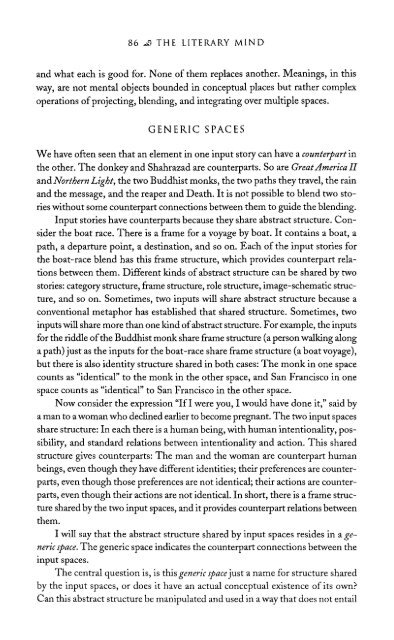The Literary Mind.pdf
The Literary Mind.pdf
The Literary Mind.pdf
Create successful ePaper yourself
Turn your PDF publications into a flip-book with our unique Google optimized e-Paper software.
86 THE LITERARY MIND<br />
and what each is good for. None of them replaces another. Meanings, in this<br />
way, are not mental objects bounded in conceptual places but rather complex<br />
operations of projecting, blending, and integrating over multiple spaces.<br />
GENERIC SPACES<br />
We have often seen that an element in one input story can have a counterpart in<br />
the other. <strong>The</strong> donkey and Shahrazad are counterparts. So are Great America II<br />
and Northern Light, the two Buddhist monks, the two paths they travel, the rain<br />
and the message, and the reaper and Death. It is not possible to blend two stories<br />
without some counterpart connections between them to guide the blending.<br />
Input stories have counterparts because they share abstract structure. Consider<br />
the boat race. <strong>The</strong>re is a frame for a voyage by boat. It contains a boat, a<br />
path, a departure point, a destination, and so on. Each of the input stories for<br />
the boat-race blend has this frame structure, which provides counterpart relations<br />
between them. Different kinds of abstract structure can be shared by two<br />
stories: category structure, frame structure, role structure, image-schematic structure,<br />
and so on. Sometimes, two inputs will share abstract structure because a<br />
conventional metaphor has established that shared structure. Sometimes, two<br />
inputs will share more than one kind of abstract structure. For example, the inputs<br />
for the riddle of the Buddhist monk share frame structure (a person walking along<br />
a path) just as the inputs for the boat-race share frame structure (a boat voyage),<br />
but there is also identity structure shared in both cases: <strong>The</strong> monk in one space<br />
counts as "identical" to the monk in the other space, and San Francisco in one<br />
space counts as "identical" to San Francisco in the other space.<br />
Now consider the expression "If I were you, I would have done it," said by<br />
a man to a woman who declined earlier to become pregnant. <strong>The</strong> two input spaces<br />
share structure: In each there is a human being, with human intentionality, possibility,<br />
and standard relations between intentionality and action. This shared<br />
structure gives counterparts: <strong>The</strong> man and the woman are counterpart human<br />
beings, even though they have different identities; their preferences are counterparts,<br />
even though those preferences are not identical; their actions are counterparts,<br />
even though their actions are not identical. In short, there is a frame structure<br />
shared by the two input spaces, and it provides counterpart relations between<br />
them.<br />
I will say that the abstract structure shared by input spaces resides in a generic<br />
space. <strong>The</strong> generic space indicates the counterpart connections between the<br />
input spaces.<br />
<strong>The</strong> central question is, is this generic space just a name for structure shared<br />
by the input spaces, or does it have an actual conceptual existence of its own?<br />
Can this abstract structure be manipulated and used in away that does not entail















